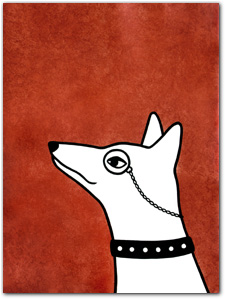
Deceivers of the Pack
2 – 30 September 2006
Port Jackson Press Print Room
Rew Hanks and Rona Green display a certain flippancy with the truth. Like the best storytellers, they’re inclined to wink at the facts, stretching their tales to make them just that little bit taller and exaggerating their exploits to make them just a little more daring. Green’s conspiracy theories and comic book preoccupations celebrate outcasts and hooligans while Hanks’ colonial ruminations are entwined with the history and mythology of the Tasmanian Tiger.
In a departure from Hanks’ signature medium and subject matter, Battle of the Bulls takes a detour into etching, and grants the Packer boys the leading roles. The grand patriarch, Frank, charges his bull elephant – that allegorical embodiment of overblown testosterone and male ego – at Kerry and James who, in turn, sit astride an even bigger ‘bully’. In an unlikely parallel to the Russian fable The Fool and the Golden Bird, the young Kerry was undervalued by his father, who had always intended the empirical throne for his favourite, Clyde. The Packer fairytale likewise sees the ‘simpleton’ returning home with the golden prize, but it is the Dodo, not the glittering bird, that Hanks awards to James: a warning reminder of the countless third generations that have squandered the family fortune.
What began as a footnote in thylacine lore has developed into a major chapter for Hanks, as he becomes increasingly fascinated with the mogul family’s exploits. Along with sheep and corgis, the Packers have entered the artist’s pantheon of colonial conquerors. Wielding cricket bats and polo mallets, mounted on horses in scenes reminiscent of Indian Mughal miniatures, the media magnate is the embodiment of power, privilege and empire. Exquisitely carved and hand water-coloured linocuts such as “There’s no devils in heaven”, said Mr Packer expose Kerry’s private passion for blood sport and his dreams of adding the elusive thylacine to the trophy cabinet (i). The title paraphrases Packer’s observation, following a near death experience, that saw no devils in the after-world; he saw no heaven either. Devils, of the Tasmanian variety, nevertheless populate this hunting idyll, being the most likely surrogates should their extinct cousin ever be cloned.
Another hunting emblem, the fox, makes a guest appearance in Green’s collaborative work with Hanks, Convict Carnivore vs Eloquent Earl. Sporting a dashing monocle and collar that identify him as a member of ‘polite’ society, this English aristocrat is the latest usurper of the thylacine’s former domain. Confident of its superiority, the vulpine invader is unperturbed by the snarling Tiger and, indeed, Hanks’ marsupial displays distinct signs of ‘colonisation’, the simplified form and disreputable stripes that hint of panel van art being decidedly Green-ian in manner.
Green’s thugs and misfits enjoy another upmarket outing in rendezvous at the opera. This sequel to Treacherous Boys With Charisma is equally glamorous and even more impressively moustachioed. Inspired by Enrico Caruso, Green’s immaculately coiffed rabbit is joined by a suspiciously elegant goat who hints at rituals less concerned with tea than virgin sacrifices and talking backwards. The high-collared capes and arachnid weavings clearly borrow from the Nosferatu School of Horror, but the dastardly charm and perfectly parted hair make these ‘culture vultures’ equally reminiscent of Buster Keaton villains.
The artist’s no-nonsense Dalmatians, Dally-Boy and Cutter, are likewise partial to bodily fluids and are not shy of solids either. The Iban tattoos on their throats brand them as head-hunters, as do the tribal arm bands and beads. The cannibals are native to Borneo, and the canines’ black and white pelts reflect Green’s first-hand impressions of an indigenous population willing to embrace the myriad cultures that have passed through this island trading post - even if the British, Chinese, Portuguese, Spanish, Indians and Philippines possibly contributed more to the ‘international cuisine’ than they bargained for.
Hanks and Green construct elaborate fibs around kernels of truth, crafting personal mythologies in which heroes and villains interchange roles, and underdogs and outsiders defy the dominant pack (or Packers, as the case may be). Fur pelts, bunny ears, Trojan Tigers and English accents serve as cunning disguises, cloaked further in humour that is razor sharp. But then again, so are the teeth.
Jazmina Cininas
Jazmina is a Melbourne based artist, writer and curator who lectures in Printmaking at RMIT. She gratefully acknowledges the artists’ generous insights into thylacine lore, Borneo culture, Mughal miniatures, the Packer family, and moustaches.
(i) The Bulletin magazine, owned by Packer at the time, offered a reward of $1.25 million for conclusive evidence that the thylacine had escaped extinction.

Rona Green
Eloquent Earl
2006 linocut, soft ground etching
and aquatint 57 x 76 cm, edition 30
published by Port Jackson Press